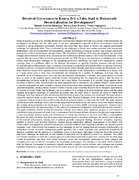| dc.description.abstract | Many democracies world over, including Kenya have in recent years adopted devolution as a system of decentralization for
development. In Kenya, this was after years of the post independence approach of Local Governments which still
embraced a strong centralized governance structure and which had been meant to resolve the regional development
challenges but apparently failed. This is evidenced by the challenges in Kenya have mainly associated with bureaucratic
inefficiencies, lack of accountability and transparency, unequal distribution of national resources and minimal community
participation in local development, amongst others. The Constitution of Kenya 2010 upon promulgation and enactment
changed the Governance structure from a centralized unit to devolved sub-units known as the County Governments. It was
expected that the onset of these devolved governments after the 2013 Elections and enactment of subsidiary laws would
address these development challenges of the centralized governance that Kenya has faced since independence. Indeed
currently, there is a deliberate effort by the National Government to equitably distribute resources through County
Government quota disbursements, there is evidence of increased accountability arising from efforts of relevant ‘watchdog’
institutions and also community participation in development matters through appropriate institutional frameworks can be
noted. However, despite these apparent positive realizations through County Governments’ establishments in Kenya, they
to a larger extent seem to have been overshadowed and threatened by a number of challenges, four years after the
enactment of the Constitution and a year into their decentralized functionality. Currently, most media houses in Kenya
have so much of the negative reports about the County Governments that the impression given is that this form of
decentralization in Kenya could be a false start if not a total failure. For example, it is currently being reported that a
Governor in Embu County, Eastern Kenya has been impeached due to impropriety, the Auditor General’s report screams
of massive impropriety in many Counties, a section of Governors have been summoned by the Senate to account for some
specified allegations, striking citizens in some Counties over one issue or another, boycotts due to ‘irregular’ appointments
by respective County Public Service Boards, the list is endless! It is in light of the aforementioned reports and the initial
apparent development challenges of centralized governance that the paper seeks to measure the extent to which these
challenges have been addressed after the decentralized devolved system of governance was introduced. The paper adopts a
diagnostic approach based on desk research to investigate these Kenyan challenges, draws from expert opinion and does
comparative analysis based on lessons from other devolved political systems in Africa and the world. The paper explores
and discusses these challenges with a view of informing other world democracies that have or are on the verge of adopting
this strategy of decentralization for development to be conscious of these pitfalls and design appropriate structures and a
roll out framework for circumventing them. It also informs Constitutional development of devolved government structures.
The paper establishes that the County Governments in Kenya have indeed made significant progress in involvement of
stakeholders on development at County level, a realization of devolvement of funds, creation of employment opportunities,
a more accountable political system and devolvement of certain key functions to the local level.This is commendable.
However, the study establishes that the Counties have been faced with a myriad of challenges that indeed stand in the way
of the realized achievements, namely lack of political goodwill, inadequate funding, ‘devolved’ corruption, nepotism,
inability to absorb some devolved functions, mistrust among stakeholders, different implementers of devolution with
varied cultures and approaches, devolved bureaucracy, a bloated workforce with duplication of duties and internal political
supremacy wars. These County Governments are also threatened by an over bearing National Assembly and Executive, an
overzealous County Assembly, deteriorating public goodwill and a weak legislature and institutional framework. It
therefore concludes that the malaise of a centralized system of governance still lingers within this devolved system and
until these challenges are addressed, no real benefits of devolution will be realized or even if so, sustained. The author
recommends legislation to allow for a phased approach to devolution preferably on pilot basis starting with the fairly large
County Governments and those with varied economic, social and demographic characteristics, more stringent anti
corruption laws and an effective mechanism for community participation. The retention of the public service functions
with the National Government to maintain a smooth transition in public service delivery and a stringent and coherent
legislative framework to guide all aspects of the devolution process are other recommendations suggested by the author. | en_US |

